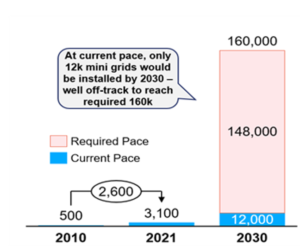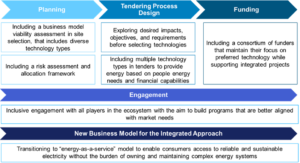Presented in AFSIA Annual Solar Outlook Report 2024
by GILLIAN ALEXANDRE HUART the CEO, PATRICK WESTMAN, Global Head of Strategy & Policy, and DIANE DOMKAM the Policy Coordinator at
As of today, 590 million people in sub-Saharan Africa (SSA) lack access to electricity, with a concerning trend projected to 2030. The challenge is exacerbated by rapid population growth, strained household incomes due to the recent pandemic, and a need for innovative solutions tailored to the region’s unique challenges.
To address the diverse energy needs in the region, a multifaceted approach is imperative.
The three main strategies each play a crucial role in addressing the varied energy needs in regions with differing infrastructure development and resource availability.
- Grid Extension: Expanding the existing national electricity grid is the primary focus, particularly in urban or peri-urban regions closer to existing infrastructure with higher energy demands.
- Mini-Grids: These small-scale, localized power networks operate independently or in conjunction with the main grid, making them ideal for remote areas.
- Standalone Systems – Solar Home Systems (SHS) and Solar Business Systems (SBS): Tailored for households or small enterprises and vital in areas with low population density or where traditional grid connections are unfeasible.
Nonetheless, achieving SDG7 requires more than just deploying these renewable energy technologies—it requires an impact-driven approach that precisely delineates the intended impacts, goals, and unique needs of the communities involved. By emphasizing these objectives, developers have the flexibility to propose innovative, bespoke solutions that align with the unique needs of each community, while leveraging the synergies of various technologies. This comprehensive strategy enhances affordability, cost efficiency, competition, and local empowerment.
Mini-grids have an important role to play in accelerating access to clean and affordable energy, as well as boosting local economies. The recent publication “Mini-Grids for Half a Billion People,” highlights the importance of mini-grids to stimulate economic activities, job creation, and ultimately, sustainable development. However, with the current pace of mini-grids development, the 2030 ambitious goals will not be met. Indeed, a 2022 ESMAP report emphasizes that of the 160,000 mini-grids needed to electrify 380 million people in SSA by 2030, only 3,100 have been installed in 2021.

As summarized in Figure 1, these numbers are alarming and prove the need to implement innovative business models, tailor a stronger regulatory framework, advocate for a more inclusive stakeholder involvement.’
Although mini grids hold significant promise and there is strong industry interest in expanding them on a larger scale, numerous challenges hinder their commercial viability. Among the challenges that we believe can be addressed in the short term, the following have been shortlisted:
- Separate tendering designs often favour distinct technologies, neglecting populations unable to afford the chosen solution, thereby hampering the economic viability of mini grid projects.
- Funder preferences limit the scope of funding and hinder the development of integrated solutions, as international funders often favour specific energy technologies.
- Integrated business model viability assessment gaps result in uncertainties and higher risks for investors. Current assessments lack thorough financial planning and overlook a crucial aspect: conducting research to assess the financial viability of the chosen technology in its intended location.
- Inclusiveness in project design is lacking, with project design predominantly led by the public sector, neglecting the crucial involvement of the private sector and diverse stakeholders.
To address the challenges mentioned above, ENGIE Energy Access has identified a way forward with clear solutions to enable the multi-technology approach in a mini-grid environment. Figure 2 below gives the steps and requirements to enable the multi-technology approach.

We strongly believe that the multi-technology approach within the mini-grid environment offers a distinct opportunity that necessitates the active engagement of a broad range of industry stakeholders and the development of a well-tailored business model across different technologies. The way forward presented above to address current challenges in the short term would require concerted and inclusive work among industry players to move toward implementation.
With only six years left to achieve the United Nations’ Sustainable Development Goals for energy, the task of providing universal energy access in sub-Saharan Africa is becoming increasingly difficult. We need an impact-driven, integrated approach using multiple technologies, centered on the energy needs of millions. As solar mini-grids are prominent, our industry needs to actively work to improve their effectiveness and profitability. Success depends on collaboration among stakeholders, and immediate next steps involve engaging the industry to consider practical aspects of implementing a multi-technology approach in mini grids.
Furthermore, as we continue our journey toward universal energy access, it is crucial to address the multifaceted challenges that lie ahead. ENGIE Energy Access will publish subsequent reports that will delve into these issues, offering insights and solutions to navigate the intricate landscape of energy access in sub-Saharan Africa.



